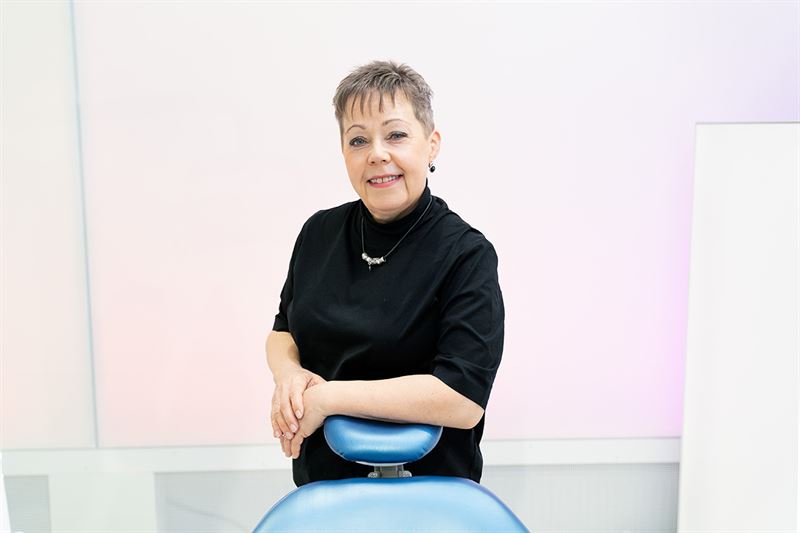Dental anxiety is essentially fear of losing control
Going to the dentist is a source of stress and anxiety for many people all around the world. However, dental anxiety is not always caused by a bad experience at the dentist’s office. So how should you approach a fearful patient? According to Professor Satu Lahti from the University of Turku, it all starts with measuring the patient’s anxiety.

According to Professor Satu Lahti from the University of Turku, there are just as many factors that contribute to dental anxiety as there are ways to manage it.
Satu Lahti could have been a lawyer. Or an architect. When she applied to the University of Kuopio Faculty of Dentistry in 1980 and got in on the first try, her first reaction was a mixed feeling of dread – “is this really it?”, she wondered. “I asked my father if I could think it over and do half a year of housekeeping school instead.” Eventually, however, she accepted the university’s offer – and hasn’t looked back since.
Today, Lahti is a Professor of Community Dentistry at the University of Turku in Finland with a doctorate in Odontology from the University of Kuopio. According to Lahti, her interest in dental anxiety was sparked by a dental fear-related research project in Kuopio, in which she participated as an assistant nurse during her studies. “It was all so interesting that I soon ended up changing the topic of both my advanced studies and my research. And that’s pretty much where it all started.”
Fear has kept us here
Dental anxiety is one of the world’s most common fears, which ranges from relatively mild stress and discomfort to extremely difficult emotional and physical reactions. However, dental anxiety is not always caused by a bad experience at the dentist’s office. So why do some people fear sitting down in the patient chair?
Lahti says many factors can contribute to an individual’s dental anxiety. To begin with, she mentions the survival of the human race throughout our known existence. Fear has, quite simply, kept us here. “The mouth is highly innervated and its cortical representation considerable. The mouth is also key to many vital functions, such as breathing, eating and social interaction. In other words, a lot of things happen in a single area of the body.”
Moreover, dental anxiety can be conditioned by pain and sounds experienced during a previous procedure. Fear can also be transmitted socially e.g. from parents to their children. There is no one answer, Lahti says. “However, at its core is the patient’s sense of not being in control.”
Everything starts with measurement
According to Lahti, the first step in approaching a fearful patient is to assess their level of anxiety. One measurement tool is the Modified Dental Anxiety Scale (MDAS) developed at the University of St Andrews in Scotland. The MDAS is a quick and concise form in which the patient answers questions about their feelings on undergoing dental treatment. The form is readily available online and in nearly 30 languages.
The patient’s responses can then be used to initiate a discussion on some of the things the patient is concerned about. “Give the patient a sense of control by describing the procedures and what they are going to feel like in a clear and understandable way, and agree on a sign which the patient can use to signal that they wish to communicate or need a break.”
In addition to using information to manage fear, Lahti recommends teaching the patient how to relieve stress through physical means, such as breathing and relaxation. “Show your patient the difference between relaxed and unrelaxed by tensing the shoulders or flexing the arms and ankles.” Even a few minutes of practice can make a difference.
Attend to the fear
Sometimes the patient may be apprehensive of the tools used in dental procedures. Common triggers include e.g. the sound and vibration of a dental drill – especially if drilling has previously caused pain. In such cases, Lahti suggests allowing the patient to familiarise themselves with the instruments. “Let the patient try with their fingernail, what a hand instrument or a low-speed micromotor feels like.”
A good patient chair also helps. An easily movable chair allows moving an unwell or nauseous patient quickly into a better position, while a soft memory foam upholstery which adapts to the patient’s body can bring some comfort to an uncomfortable situation. “It is important that the chair makes the patient feel relaxed and safe,” Lahti states.
Finally, it is also good to observe the patient’s body language and to communicate with them throughout the treatment. This communication can be verbal, but also visual by using e.g. a mirror or a dental unit-integrated monitor to describe the treatment and its progress – however the patient prefers.
The important thing, however, is to approach a fearful patient with understanding, to listen to them and to make anxiety assessment a daily routine. “Use those few simple means of managing fear and take a moment to attend to it.”
Copy: Aleksandra Nyholm
Image: Dino Azinur
Planmeca Oy and Planmeca Group
Planmeca Oy is one of the world's leading dental equipment manufacturers with a product range covering digital dental units, CAD/CAM solutions, world-class 2D and 3D imaging devices and comprehensive software solutions. Headquartered in Helsinki, Finland, Planmeca’s products are distributed in over 120 countries worldwide. With a strong commitment to pioneering innovations and design, it is the largest privately held company in its field. Planmeca Oy is part of the Finnish Planmeca Group, which operates in the field of healthcare technology. The Group's turnover in 2019 was MEUR 770, and it employs nearly 2,800 people worldwide.
www.planmeca.com
Tags:


